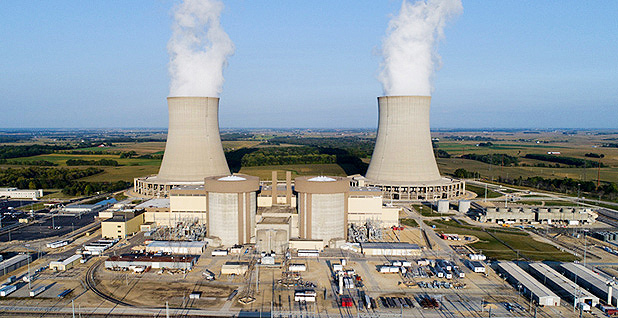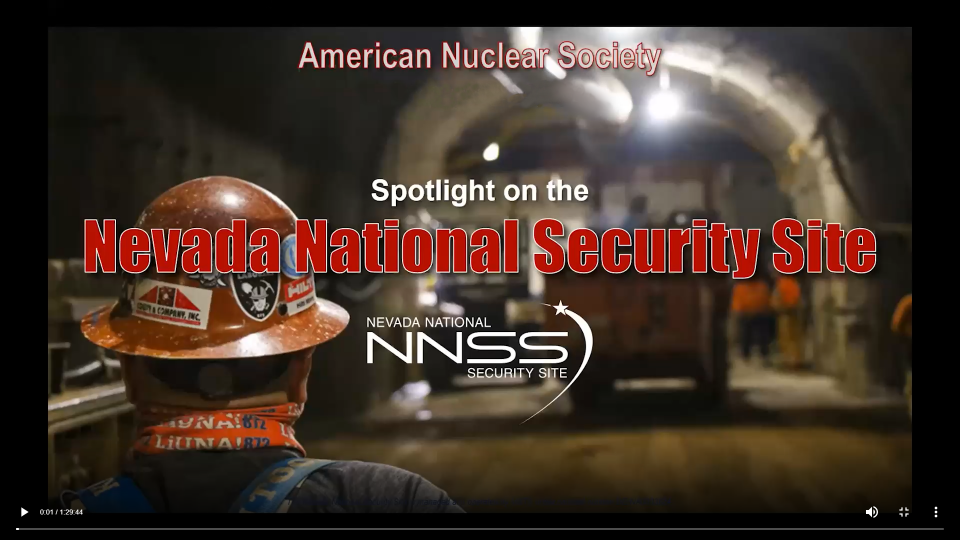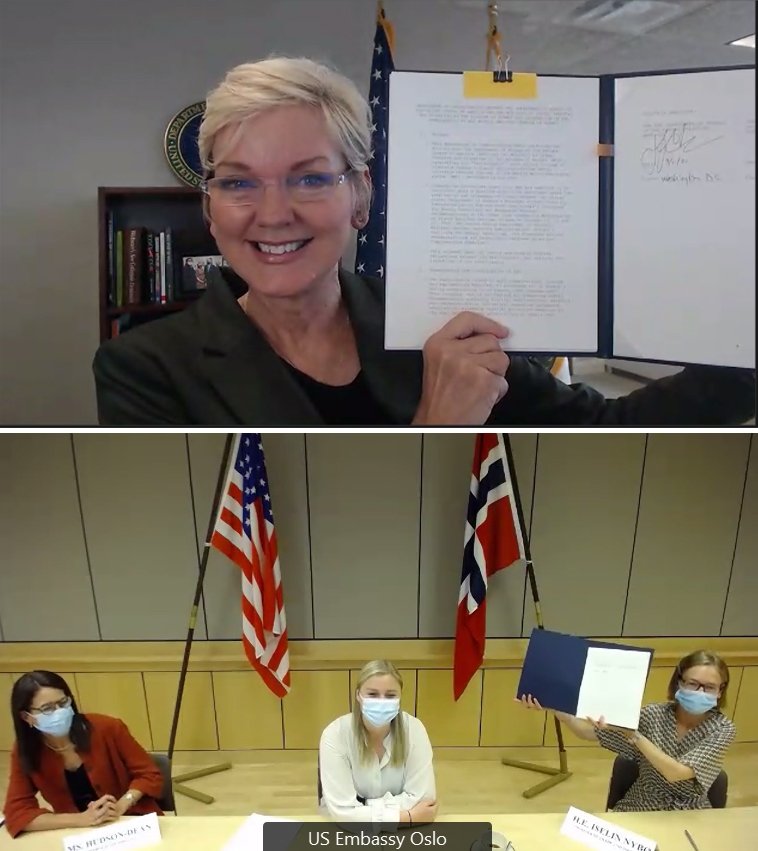This large-bore, full-scale high-temperature superconducting magnet designed and built by Commonwealth Fusion Systems and MIT’s Plasma Science and Fusion Center is the strongest fusion magnet in the world. (Photo: Gretchen Ertl, CFS/MIT-PSFC)
A high-temperature superconducting magnet reached and maintained a magnetic field of more than 20 tesla in steady state for about five hours on September 5 at MIT’s Plasma Science and Fusion Center. Not only is the magnet the strongest high-temperature superconducting (HTS) magnet in the world by far, it is also large enough—when assembled in a ring of 17 identical magnets and surrounding structures—to contain a plasma that MIT and Commonwealth Fusion Systems (CFS) hope will produce net energy in a compact tokamak device called SPARC in 2025, on track for commercial fusion energy in the early 2030s.
The Byron nuclear power plant
(This story has been updated from yesterday's post about the Illinois energy package.)
With only days remaining before the scheduled retirement of Exelon Generation’s Byron nuclear plant, the Illinois House has approved a comprehensive energy package (S.B. 2408) that would save the plant, as well as the state’s similarly struggling Braidwood and Dresden facilities.
A rendition of the VTR. (Graphic: DOE)
In an op-ed published online yesterday in The Hill, Ted Nordhaus and Adam Stein of the Breakthrough Institute pick apart arguments made against funding for the construction of the Versatile Test Reactor at Idaho National Laboratory. Nordhaus and Stein contend that opposition to the VTR has been led by “entrenched opponents of nuclear energy” who “fear that innovation of the sort that many U.S. nuclear startups are presently betting on might give the technology a second life.”
Energy secretary Jennifer Granholm (seated at left) and Ukrainian energy minister Herman Galushchenko (seated at right) on August 31 sign an agreement to bolster U.S.-Ukrainian energy cooperation. Ukraine’s president, Volodymyr Zelensky, stands in the background. (Photo: DOE)
U.S. energy secretary Jennifer Granholm and Ukrainian energy minister Herman Galushchenko last week signed a joint statement of intent to advance energy and climate cooperation through the U.S.-Ukraine Strategic Energy and Climate Dialogue. The signing took place during a visit to Washington, D.C., by Ukrainian president Volodymyr Zelensky for meetings with President Biden at the White House.
Operators disassemble a cutter head inside a module at the Savannah River's Tritium Extraction Facility using manipulators and hand tools. (Photo: SRNS)
Using basic hand tools and remote manipulators, operators at Savannah River Nuclear Solutions (SRNS) were able to reduce radiation exposure to workers performing cutter head maintenance in the Savannah River Site’s Tritium Extraction Facility (TEF).
According to SRNS, the innovative procedure proved to be an excellent example of real-world application of As Low As Reasonably Achievable (ALARA) principles of time, distance, and shielding.
NorthStar is challenging the sale of Kewaunee to EnergySolutions. (Photo: Dominion Generation)
NorthStar Group Services is being allowed to intervene in Wisconsin’s regulatory review of the sale of the Kewaunee nuclear power plant by Dominion Energy to EnergySolutions for decommissioning. An administrative law judge granted NorthStar permission on September 7 to participate in the Public Service Commission of Wisconsin’s review of the transaction.
During a recent road closure on the Hanford Site, Florida International University students (from left) Jeff Natividad, Joel Adams, and Thi Tran test a radiation mapping robot outside a tank farm. The students are part of a unique internship program between the DOE’s Office of Environmental Management and the university. (Photo: DOE OEM)
As part of a fellowship program between the Department of Energy’s Office of Environmental Management and Florida International University, a group of FIU students participated in a summer internship initiative called the Science and Technology Workforce Development Program. The program is run in conjunction with Washington River Protection Solutions (WRPS), the Hanford Site’s tank operations contractor in Washington state.
A statement from Steven P. Nesbit, president of the American Nuclear Society, and Lonnie R. Stephenson, international president of the International Brotherhood of Electrical Workers.
September 8, 2021, 6:59AMANS Nuclear CafeSteven P. Nesbit and Lonnie R. Stephenson America’s electric utility workers and nuclear engineers are ready to work together to help rapidly decarbonize and electrify the economy. We welcome provisions in the bipartisan infrastructure bill that aim to prevent premature closures of our nuclear power plants. Through measures such as production tax credits, President Biden can safeguard America’s largest carbon-free energy source by recognizing the clean-air contributions of nuclear energy.
During the week-long mission, the IAEA team is carrying out practical NDT training with specialized equipment. (Photo: Abel Domato/BAC)
In the aftermath of a devastating explosion in the port of Beirut, Lebanon, in August 2020, an International Atomic Energy Agency team visited the country at the government’s request and found no evidence of artificial radionuclides and no increase in radiation levels. The powerful blast, which was caused by an explosion of improperly stored ammonium nitrate, killed more than 200 people and leveled numerous buildings while leaving other buildings standing with possible structural damage. The IAEA recently announced that a different team of experts has traveled to Lebanon with a new mission: to assist the nation in the use of non-destructive testing (NDT) to check the structural soundness of buildings that were impacted by the explosion.
A graphic representation of the tendons encircling the San Onofre containment domes. (Image: SCE)
A nearly yearlong effort to de-tension and remove more than 400 steel cables, known as tendons, from the two containment domes of the San Onofre Nuclear Generating Station (SONGS) was recently completed, with only one minor first aid incident recorded, according to Southern California Edison.
Energy Harbor’s Beaver Valley nuclear plant in Shippingport, Pa.
In an action that could make Pennsylvania’s nuclear plants more cost-competitive in power markets, the state’s Independent Regulatory Review Commission has approved a regulation that would allow Pennsylvania to join the Regional Greenhouse Gas Initiative (RGGI), a cooperative effort of Northeastern and Mid-Atlantic states designed to cap and reduce carbon emissions from fossil fuel–fired power plants.
The Byron (left) and Dresden generating stations.
Exelon’s Byron nuclear plant will be permanently shuttered in 10 days unless the Illinois House of Representatives passes the clean energy bill approved by the state’s Senate on September 1. And as the lower chamber is expected to convene for a special session sometime next week to consider the measure, ANS is encouraging members of Illinois’s nuclear community to make their position on the matter clear via ANS engage.
A NuScale representative conducts training on the nuclear power plant control room simulator for students and faculty at CAES. (Photo: CAES)
The Center for Advanced Energy Studies (CAES) has announced the opening of the Small Modular Reactor Simulator Laboratory, featuring NuScale Power’s Energy Exploration Center, at its headquarters in Idaho Falls, Idaho. The new lab will increase CAES’s capabilities to train future scientists, engineers, and members of the energy workforce and will be used to educate the public about nuclear energy and reactor technology, according to an August 31 CAES press release.










 Nuclear power plants around the world generated 2,553 TWh of electricity in 2020, a drop of 104 TWh from 2019’s total, according to
Nuclear power plants around the world generated 2,553 TWh of electricity in 2020, a drop of 104 TWh from 2019’s total, according to 








